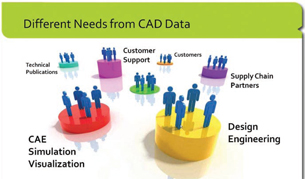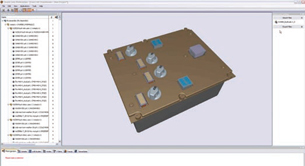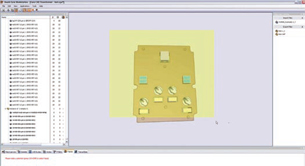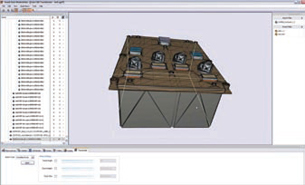Anark Core 2.0 Crosses the Great Divide
Manages your changes and easily communicate model information to any stakeholder you want to satisfy a host of different needs.
Latest News
January 1, 2009
By Mike Hudspeth
 Figure 1: Everyone has needs, and they’re usually different from the needs of the next guy. Anark Core 2.0 seeks to address the needs of your entire organization. |
You’ve heard of the Great Divide, yes? No, not the ridge along the Rocky Mountains that separates the North American continent, the other one. The one that divides engineers from everyone else. Anyone who has ever read a Dilbert cartoon has seen examples of it.
Engineers are very detail and fact oriented. Logic and accuracy are paramount. But what about the rest of the world? After all, not everyone is an engineer.
As an industrial designer, I straddle this Great Divide. I understand the value of precise engineering, but also know a beautiful product will always sell better than a merely functional one. Consumers don’t usually care HOW a product works, they just want it TO work while looking good. And that means that engineers must engage in a certain amount of compromise to create a top-selling product, which means precision will not always be maintained throughout the product-development process. And during this process, different groups will have different needs. Anark Core 2.0 is one good way to coordinate and fulfill all those different needs.Help with Visualizations
In a nutshell, Anark Core 2.0 is a program that manages the changes you need to make to your models to communicate them to a less technical audience. It helps create visualizations for many different needs.
 Figure 2: The Anark Core 2.0 interface is very simple and straightforward. It resembles an assembly BOM for good reason. There are icons across the bottom that give you all the functions you’re going to need to do your work. |
I once worked for a company that made a fairly complicated electronic product. When it came time to create the user’s manual and service manual we would export our precise 3D model as a CGM file, effectively flattening it and freezing it in time. We would then bring it into our illustration program and “dumb it down” to make it clearer for people to see. We would do things like eliminate blend edges and such, aiming to simplify it. More times than not, our art department would then redraw our simplification to get what they thought they wanted. These illustrations were always inaccurate. Then, we made changes to the 3D models. There was no easy way to change the illustrations, so they then had to be reworked manually by the artists. It was a very labor-intensive system that retained none of the intelligence inherent in the 3D solid models.
Anark Core 2.0 sort of automates many aspects of the illustration process. I say “sort of” because you still have to do the changing yourself the first time, but after that it becomes automatic. How is that possible you ask?
Anark has partnered with (or licensed) just about every 3D modeling package out there. It can translate just about anything into and out of Anark Core 2.0. That is a great thing. If nothing else, it will allow you to have a very good translator. It will directly open your 3D model file and save it in Anark Core 2’s proprietary format. Once there, you can begin to simplify your parts.
 Figure 3: You just window in what you want to select and depending on how you have your settings you will be able to select with precision. |
Simple Defeaturing
If you’ve ever had to transfer an assembly, then you know how big those files can get. I’ve had assembly files that topped out in the hundreds of megabytes. Obviously those are not going to be the easiest files to email to someone.
It might be accurate to include the engine in the car model, but if you never pop the hood and actually see it, it becomes electronic dead weight. It will only serve to slow you down. Anark Core 2.0 gives you all kinds of tools to rapidly “de-feature” your parts and assemblies.
Now, you can eliminate the parts you won’t see, but that will only go so far. If you need to go further and pop the hood, Anark Core 2 lets you select faces to create a lite part. If all you need are the faces you can see, you can shrink your actual assembly size.
Easy to Use
Anark Core 2.0 gives you some very powerful tools in a clean interface (see Figure 2) with which you can accomplish your simplification. First, it has a “blanket ray tracer” that will only select what you can see. If you have it set for solids, that’s what you’ll get. If you set it for surfaces, that’s all it’ll select. You just position the model how you want it create a window around what you want (see Figure 3). You can also constrain your selection by object size. For example, you can eliminate screws and bolts from a large assembly. In fact, you can completely rework assemblies, adding and omitting parts as you please. You can even rename items in your BOM tree. You can move parts around to different locations, but you’ll have to eyeball them. I’m told that precise location (mating) will come some time in 2009.
Once you have your file the way you want it, you save it out to whatever program you want. Most often people send the file out to an illustration package for their technical illustrators, but frequently it goes to a 3D modeling program. Why would you want your files dumbed down if they’re going to a 3D package? You may have a vendor or customer who has a legitimate need for a model, but you might not want to show them everything.
 Figure 4: You can tessellate your files to reduce the accuracy in areas that may be sensitive. A tessellated model is broken up into triangles of various sizes. |
In this way, Anark Core 2.0 enables you to give the customer what he wants while protecting your IP. You can even save your files out at different resolutions. If you need to send out something so a vendor can build something else around it, you can change the resolution of the model in areas that are sensitive (see Figure 4) and leave the resolution higher in other areas.
Innovation You Can See
One of the last and most important reasons to check out Anark Core 2.0 is its innovation in automation. As you take the steps de-featuring, making changes, altering resolution, prepping your model for export, Anark Core creates what it calls a “recipe.” I like to compare it to a macro. The next time you need to make those same changes to your models you just open the newly changed file, access the appropriate recipes, and in no time your models are good to go. If the changes made result in things Anark Core 2.0 cannot reconcile, it will ask you to step in and tell it what to do.
There are several versions of Anark Core 2.0 to choose from depending on your translation needs. There is Exchange (which is the base package), Professional (that has a huge number of translation formats), and Enterprise (it does it all). There is also a Server setup if you want to implement Anark Core 2.0 across your network. If you are interested in seeing more of Anark Core 2.0, you can visit anark.com. You’ll be glad you did.
More Info:
Anark Corporation
Boulder, CO
Mike Hudspeth, IDSA, is a senior designer for a global medical company and has been using a wide range of CAD products for more than 20 years. Send e-mail about this article to [email protected].
Subscribe to our FREE magazine, FREE email newsletters or both!
Latest News






